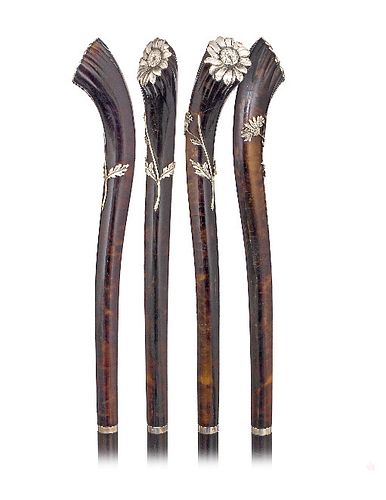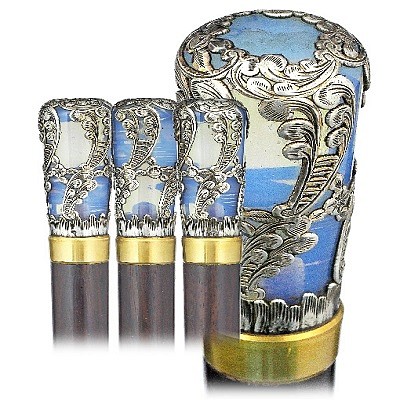Tortoiseshell and Silver Cane
Lot 56
About Seller
Kimball Sterling
125 West Market Street
Johnson City, TN 37604
United States
Family-owned and family-run Johnson City Tennessee auction business for 25 years. Selling antiques and collectables for 38 years. Kimball M. Sterling, Inc. was founded and is owned by Kimball and Victoria Sterling, time and again, they have laid solid claim to world-wide attention and renown with an...Read more
Categories
About Auction
By Kimball Sterling
Oct 31, 2020 - Nov 15, 2020
Set Reminder
2020-10-31 00:00:00
2020-11-15 23:00:00
America/New_York
Bidsquare
Bidsquare : Canes and Walking Sticks
https://www.bidsquare.com/auctions/kimball-sterling/canes-and-walking-sticks-5893
Timed auction of canes and walking sticks Kimball Sterling kimballsterling@earthlink.net
Timed auction of canes and walking sticks Kimball Sterling kimballsterling@earthlink.net
- Lot Description
Ca. 1900-Very tall and tapering solid tortoiseshell handle fashioned in a beautiful swayed configuration and embellished, on the top, with a well-chased silver rosette to simulate a daisy, and on the side, with an applied stalk with leaves and bloom. The handle ends with a slender silver collar with an “A.W” hallmark for Anton Wildhack, Vienna and comes on an ebony shaft with a matching horn ferrule. The tortoiseshell part itself shows a darker color with the valued streaked structure of the noble sea material and its magical translucency and discreet shine. Ergonomically designed for the perfect fit to the hand, this cane seems to be a singular item of its kind. Despite an excessive fragility and lots of characterlines to the surface, it survived in good condition. Tortoiseshell handles are extremely rare, they were very difficult to make and among the most expensive of their time. Today, the few surviving examples are in museums and the great pride of renowned cane collections. Vienna was specialized in tortoiseshell articles and had the best artists in that field. H. 11 ½” x 2 ½”, O.L. 39 ¾” Anton Wildhack (Previously M. Wildhack & Sohn) Juwelier, Gold- and Silberschmied Gewerbsverleihung: 1872 Gewerbezurucklegung: Dezember 1908 VI, MagdalenenstraBe 52 (1874); IV, Klagbaumgasse 9 (1893 - 1908) Erzeugung: „Goldbijouterie. — Heraldische Kunstgegenstande, Wappen“ (Kalender 1898) Tortoiseshell is an ornamental material obtained from the curved, horny shields forming the shell of the Hawksbill or of the Caretta turtle. The marbled, variegated pattern and deep translucence of the plates have been used in veneering and in the manufacture of jewelry and other items since ancient times. Tortoiseshell was imported to Rome from Egypt and has found many uses throughout the centuries from the time it was first introduced to Europe by the East India Company in the 17th century. Tortoiseshell work was raised to the level of artistry with design applications such as veneer over wood with bone and ebony trimmings, marquetry, lacquered versions and inlays with gilded flowers, gold or silver. It became popular in the East as well as in Europe, where it was used as a material for jewel cases, trays, snuffboxes, canes and other decorative articles. Tortoiseshell is first separated from the bony skeleton by heat; the shields are flattened by temperature and pressure, and irregularities are rasped away. It can be molded after being softened in boiling oil, shaped on a lathe and also takes a beautiful polish. Current environmental concerns have limited the use of tortoiseshell, and the knowledge of handling this noble and beautiful material is now totally lost.
- Shipping Info
-
Each auction has different shipping terms but the buyer always pays.Canes:After payment has been received we will ship in-house the domestic orders, International bidders will be shipped by the UPS store (423-979-7122) and email store4146@theupsstore.com After we receive payment we will deliver to the UPS store and they will contact you.Other Auctions:After payment has been received and cleared we will deliver your items to the UPS Store and they will quote and prepare for shipping.phone (423-979-7122 and email store4146@theupsstore.com
-
- Buyer's Premium



 EUR
EUR CAD
CAD AUD
AUD GBP
GBP MXN
MXN HKD
HKD CNY
CNY MYR
MYR SEK
SEK SGD
SGD CHF
CHF THB
THB



















